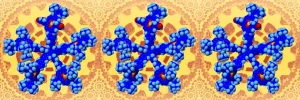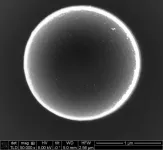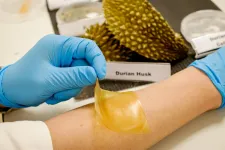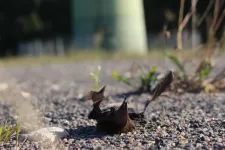Arctic sponge survival in the extreme deep-sea
2021-03-25
(Press-News.org) For the first time, researchers from the SponGES project collected year-round video footage and hydrodynamic data from the mysterious world of a deep-sea sponge ground in the Arctic. Deep-sea sponge grounds are often compared to the rich ecosystems of coral reefs and form true oases. In a world where all light has disappeared and without obvious food sources, they provide a habitat for other invertebrates and a refuge for fish in the otherwise barren landscape. It is still puzzling how these biodiversity hotspots survive in this extreme environment as deep as 1500 metres below the water surface. With over 700 hundred hours of footage and data on food supply, temperature, oxygen concentration, and currents, NIOZ scientists Ulrike Hanz and Furu Mienis found clues that could help find some answers.
Colourful, thriving communities
'The deep sea, in most places, is barren and flat', says marine geologist Furu Mienis. 'And then, suddenly, we have these sponge grounds that form colourful, thriving communities. It is intriguing how this system sustains itself in such a place.' To better understand this unexpected success, the research team deployed a bottom lander equipped with sensors and an underwater camera specially designed for the extreme environment by NIOZ engineers and technicians. The location: an enormous seamount in the Norwegian Sea that is part of the Mid Atlantic ridge, known as the Schulz Bank. A year later they picked it up. What they saw and measured was a world where sponges survived in temperatures below zero degrees Celsius and withstood potential food deprivation, high current speeds and 200-metre-high underwater waves.
Mienis: 'We still don't get why they grow where they grow, but we are off to a good start of a better understanding. Apparently, this seamount and the hydrodynamic conditions create a beneficial system for the sponges.' A major finding located the sponge ground at the interface between two water masses where strong internal tidal waves can spread widely? and interact with the bottom landscape. The data from the sensors showed that the water flow at the summit of the seamount interacts with the seamount itself, producing turbulent conditions with temporarily high current speeds reaching up to 0.7 meter per second, which can be considered as "stormy" conditions in the deep sea.
At the same time, water movements around the seamount supply the sponge ground with food and nutrients from water layers above and below. The team measured the amount of food sinking from the surface to the sponge grounds and found that in this vertical direction, fresh food was delivered only once during a major event in the summer when the phytoplankton bloomed. Hanz: 'This isn't enough to sustain the sponge grounds, which is why we expect that additionally, bacteria and dissolved matter keep the sponges and associated fauna from starving.
Extreme environment
The long-term record shows that the sponges on Schulz Bank thrive at temperatures around zero degrees Celsius. This is at least 4 °C lower than stony cold-water corals that are also found in the deep sea. Hanz: 'It is striking that they are alive with temperatures at zero degrees or even less. This is quite extreme, even for the deep sea.' In this food-deprived environment, the cold might actually play a role in the sponge's survival by lowering its metabolism. And the cold isn't the only extremity they face. Video recordings of the highest current speed events in winter show that these 'storms' further push the sponges to their limit. Hanz: 'The speeds that we witnessed, might be close to the maximum that they can endure. At the highest speed, we saw some sponges as well as anemones being ripped from the seafloor.'
And the most remarkable thing after watching hundreds of hours of footage? Hanz: 'The image that I started with was almost the same as the image in the end. One year had gone by and everything looked almost the same. It's just so cold out there that no crazy things are going on. The reef is still very pristine.' However, Hanz and Mienis stress that it is a very vulnerable ecosystem. Hanz: 'Sponges can be up to two hundred years old, once damaged it takes ages for them to recover.' And there are potential threats. Hanz: 'Fishery seems to be the biggest one, but there is also the future possibility of deep-sea mining and changes in temperature and turbulence caused by climate change. Mienis: 'It is a fragile equilibrium that consists of many tiny components. Take one of those away and the whole system can collapse.' Their research contributes to a first baseline that might become essential in future protection. Mienis: 'We now identified the first natural ranges, and gathered a bit of the information on how these rich sponge grounds can thrive.'
INFORMATION:
[Attachments] See images for this press release:
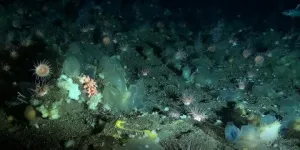
ELSE PRESS RELEASES FROM THIS DATE:
2021-03-25
Ikoma, Japan - Gear trains have been used for centuries to translate changes in gear rotational speed into changes in rotational force. Cars, drills, and basically anything that has spinning parts use them. Molecular-scale gears are a much more recent invention that could use light or a chemical stimulus to initiate gear rotation. Researchers at Nara Institute of Science and Technology (NAIST), Japan, in partnership with research teams at University Paul Sabatier, France, report in a new study published in Chemical Science a means to visualize snapshots of an ultrasmall ...
2021-03-25
People who are physically active on a regular basis recover better after surgery for colorectal cancer. However, starting to exercise only after the diagnosis is a fact had no effect on recovery, a University of Gothenburg thesis shows.
In working on his thesis, Aron Onerup, who obtained his doctorate in surgery at the University's Sahlgrenska Academy and is now a specialist doctor at Sahlgrenska University Hospital, carried out an observational study of 115 patients diagnosed with colorectal cancer.
The participants who had been physically inactive proved, three weeks after their surgery, to be at higher risk of not feeling that they ...
2021-03-25
Microswimmers are artificial, self-propelled, microscopic particles. They are capable of directional motion in a solution. The Molecular Nanophotonics Group at Leipzig University has developed special particles that are smaller than one-thirtieth of the diameter of a hair. They can change their direction of motion by heating tiny gold particles on their surface and converting this energy into motion. "However, these miniaturised machines cannot take in and learn information like their living counterparts. To achieve this, we control the microswimmers externally so that they learn to navigate in a virtual environment through what is known as reinforcement learning," said Cichos.
With the help of virtual rewards, the microswimmers find their way through the liquid ...
2021-03-25
Food scientists from Nanyang Technological University, Singapore (NTU Singapore) have made an antibacterial gel bandage using the discarded husks of the popular tropical fruit, durian.
Known as the "King of Fruits" in Southeast Asia, the durian has a thick husk with spiky thorns which is discarded, while the sweet flesh surrounding the seeds on the inside is considered a delicacy.
By extracting high-quality cellulose from the durian husks and combining it with glycerol - a waste by-product from the biodiesel and soap industry - NTU scientists created a soft gel, similar to silicon sheets, which can be cut into bandages of various shapes and sizes.
They then added the organic molecules produced from baker's yeast known as natural yeast phenolics, making the bandage deadly ...
2021-03-25
In order to assess the risk of bats dying at wind turbines, it is common practice to record the acoustic activity of bats within the operating range of the rotor blades. For this purpose, ultrasonic detectors are attached to the nacelles of the mast top. In a recent analysis, a team of scientists led by the Leibniz Institute for Zoo and Wildlife Research (Leibniz-IZW) concludes that the effectiveness of this acoustic monitoring is insufficient to reliably predict mortality risk, especially for bats at large turbines. They therefore recommend installing supplementary ultrasonic detectors at other locations on the wind turbines and developing additional techniques such as radar and thermal imaging cameras for monitoring. The results of their analysis are published in ...
2021-03-25
European listed companies in the energy and mining sector provide, to say the least, sparse information on future environmental costs in their annual reports. Researchers believe that stricter guidelines are required as the lack of information may lead to underestimation of environmental liabilities, resulting in that future generations may have to bear the burden of cleanup costs.
"I believe that the future environmental liabilities such as decommissioning costs are often underestimated and few understand the burden these costs might impose on future generations. If, for example, an oil & gas company fails, it costs an incredible amount to clean up after old oil wells and the risk is great that the taxpayers will have to pay the bill. Therefore, it is important that environmental obligations ...
2021-03-25
Increased allergic reactions may be tied to the corticotropin-releasing stress hormone (CRH), suggests a study published this month in the International Journal of Molecular Sciences. These findings may help clarify the mechanism by which CRH induces proliferation of mast cells (MC) - agents involved in the development of allergies in the human nasal cavity.
"In my daily practice, I meet many patients with allergies who say their symptoms worsened due to psychological stress," states lead researcher Mika Yamanaka-Takaichi, a graduate student of the Department of Dermatology, Osaka City University, "This is what led me to do this research."
Together with Professor Daisuke Tsuruta of the same department, they hypothesized that due to its ...
2021-03-25
Bright but disadvantaged students from urban areas are more likely to enter elite UK universities than similar peers from rural communities due to an urban 'escalator effect', according to a new study.
Researchers from the University of Bath analysed data from 800,000 English students commencing university in the years 2008, 2010, 2012, 2014 and 2016.
They found that while in general rural areas had higher overall progression to university than city centres and surrounding areas, when controlling for factors including socio-economic status, age, ethnicity and sex, disadvantaged pupils from rural areas were less likely to progress to one of 27 'top' UK universities.
The authors suggest the difference ...
2021-03-25
NIMS and RIKEN have succeeded in synthesizing the longest ever bottlebrush polymer. This polymer--resembling a green foxtail--is composed of a main chain and numerous side chains grafting from it. The team also succeeded in giving various chemical properties to the ultralong bottlebrush polymer. These achievements are expected to substantially advance the current synthetic methods of bottlebrush polymers. This technique may be applicable to the development of flexible and low-friction polymeric materials.
In the development of polymeric materials, it is necessary to link molecular units with desired chemical properties, called monomers, to ...
2021-03-25
Prof. ZHAO Jin's research team from University of Science and Technology of China (USTC) has made important progress in the development of Spin-Valley exciton dynamics. The research developed an ab initio nonadiabatic molecular dynamics (NAMD) method based on for the spin-resolved exciton dynamics. The team gained the first clear and complete physical picture of valley exciton dynamics in MoS2 from the perspective of first-principles calculations based on GW plus real-time Bethe-Salpeter equation (GW + rtBSE-NAMD).
It can accurately include many-body effects at the level of first principles and break through the bottleneck of GW+BSE method in ...
LAST 30 PRESS RELEASES:
[Press-News.org] Arctic sponge survival in the extreme deep-sea

